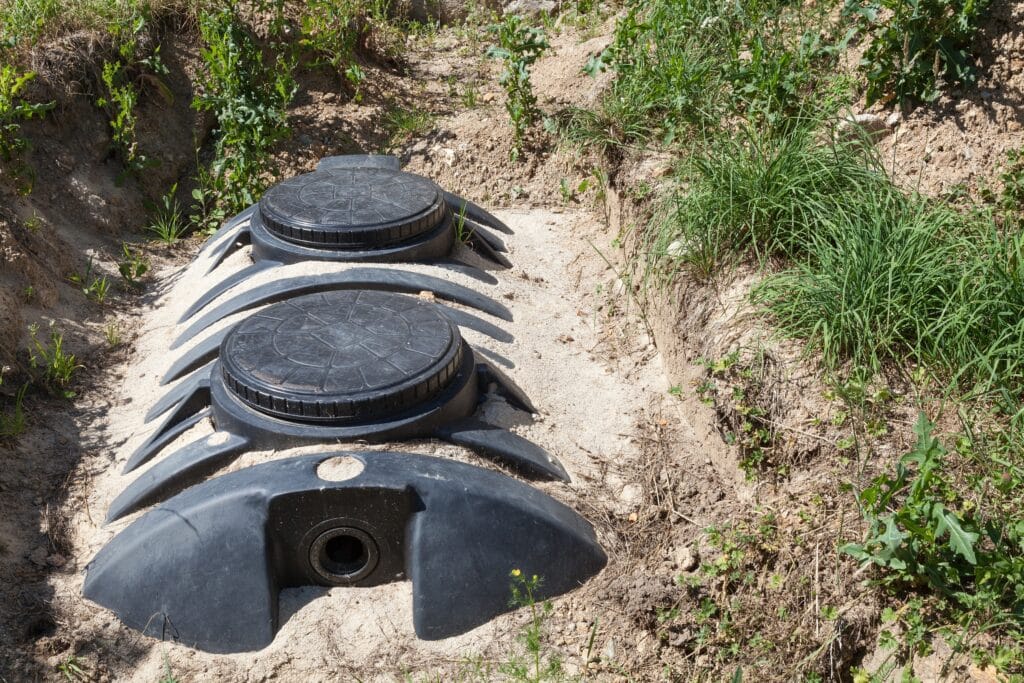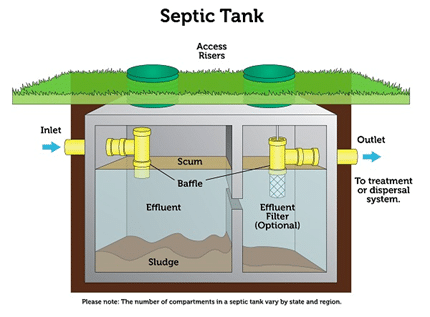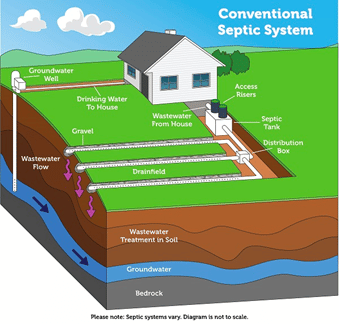
New septic tank for a domestic house installed in a sand bed ready for connection to the gravel filter bed for disposal and treatment of household effluent and sewage. Image by Gozzoli via Shutterstock.
Have you ever wondered where your water goes after you use it? For most communities, sewage and wastewater go to centralized sewage systems that treat human waste and easily degradable solids. In more suburban and rural communities, it’s not uncommon for private properties to use septic systems to treat wastewater.
What are septic systems? They are underground wastewater treatment structures that combine natural and technological processes to treat wastewater from household plumbing.
How do they work? Septic systems usually consist of a septic tank and drainfield. The septic tanks are buried, watertight containers made from concrete, fiberglass, or polyethylene plastic that separate solid waste and oils from the wastewater.
The liquid wastewater, or effluent, is then transported to the underground drainfield, where it trickles through the soil into groundwater. This allows any viruses, nutrients, and harmful coliform bacteria (gut bacteria) to be filtered from the water.
For less densely populated areas, septic systems provide many benefits, including reduced treatment costs, slowed spread of diseases, and prevented water pollution. However, when septic systems fail or are poorly maintained, they can also lead to major issues such as algae growth in surface water bodies and contaminated drinking water supplies.
Because failed septic systems are very costly to fix or replace, many communities have established funding programs to help residents cover the costs for replacement and inspection. We will now look at how three different communities in the state of New York (NYS) offset some of these costs.
Lake George, NY
In Lake George, the Lake George Park Commission, a NYS agency, was charged with the long-term protection of Lake George and its legendary water quality. When the commission found that the lake was vulnerable to impacts from failed septic systems, it identified the need for a recurring inspection program that inspected the septic systems and ensured their proper functioning every five years.
After reviewing past literature on septic systems, understanding the current Lake George septic system, and looking at case studies of other NYS Septic Inspection Programs, the commission ultimately decided to hire seasonal technicians to conduct regular inspections of the septic systems in the Lake George community. This would allow the commission to take on some of the program administration and off-season inspections, as well as maintain consistency and programmatic integrity. The program would be funded by inspection fees imposed on septic system owners.
More information about the program can be found here.
Suffolk County, NY
The Septic Replacement Loan Program for Suffolk County Residents is a part of the Suffolk County Septic Improvement Program funded by the Community Development Corporation of Long Island (CDCLI). How does it work? Homeowners can apply for a grant from Suffolk County to help fund the replacement of outdated and failing septic systems with state-of-the-art nitrogen reducing systems.
If the homeowner still needs more money to cover the installation costs, the CDCLI will then offer low interest loans up to $10,000. The purpose of the loan is to provide funds in case the Suffolk County grant is insufficient to cover the full installation costs for the replacement septic system.
More information about the program can be found here.
Ontario County, NY
Through its Soil & Water Conservation District, Ontario County offers a multitude of programs such as the Canandaigua Lake Watershed Inspection Program and the Onsite Wastewater Treatment System Inspections program.
The Canandaigua Lake Watershed Inspection Program provides inspections of septic systems, consults for new construction and repairs of systems, reviews building plans for suitability of wastewater treatment, and responds to spills and work toward containment. The program would be carried out by the Canandaigua Lake Watershed Inspector and is self-funded.
The Onsite Wastewater Treatment System Inspections program provides required inspection services for Ontario County municipalities, as well as other municipalities as needed. It includes conducting inspections of onsite wastewater treatment systems including for property deed transfers. It also provides education, information, and consultation to homeowners and residents. The program is primarily operated by the district’s technician and is funded by inspection fees.
More information about the programs can be found here:
- Canandaigua Lake Watershed Inspection Program: https://www.ontswcd.com/canandaigua-lake-watershed
- Onsite Wastewater Treatment System Inspections: https://www.ontswcd.com/onsite-wastewater-treatment
Ultimately, there are many different forms a septic funding program can take to help homeowners cover the high costs of replacement and inspection services. Putting a septic funding program in place helps to ensure proper maintenance while reducing costs and protecting public health and environmental quality.



